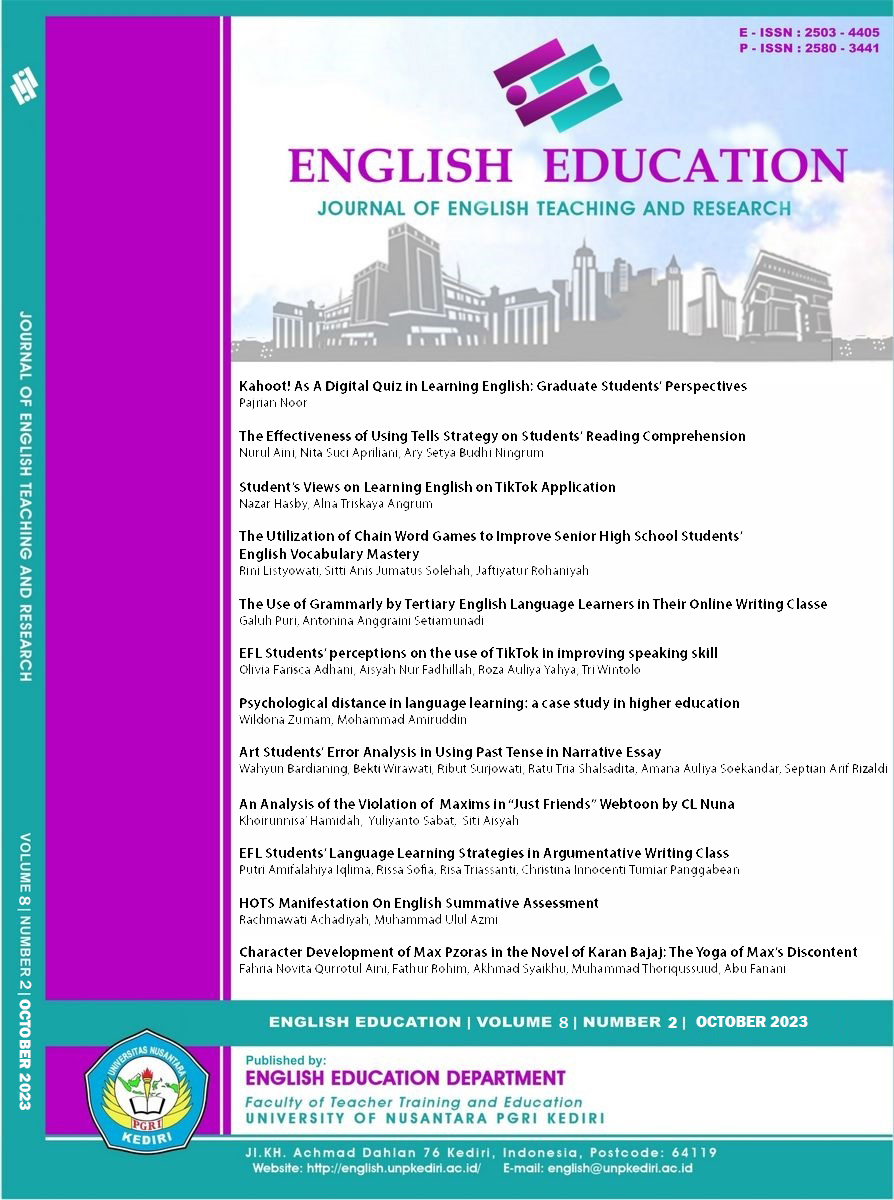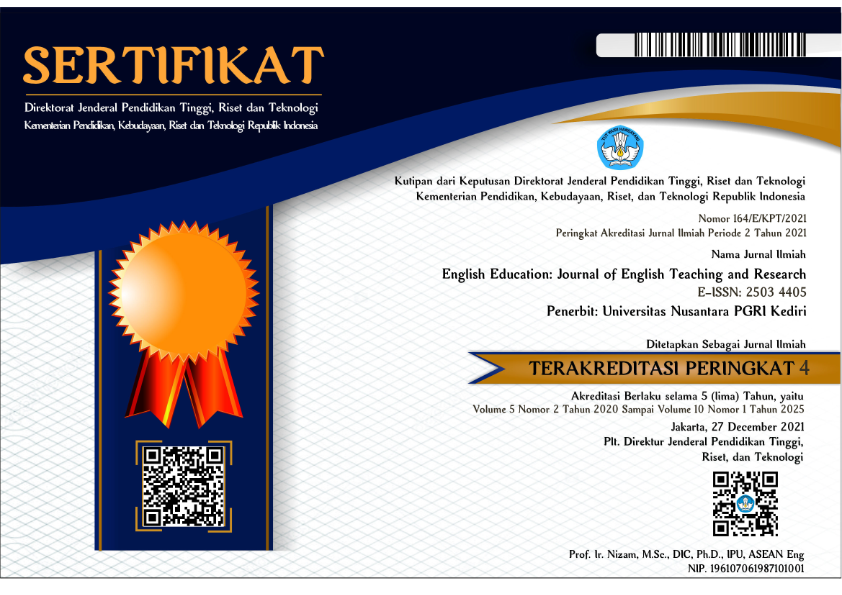The Max Pzoras’ Character Development in Karan Bajaj’s the Yoga of Max’s Discontent
Max Pzoras’ Character Development in Karan Bajaj’s the Yoga of Max’s Discontent
DOI:
https://doi.org/10.29407/jetar.v8i2.20396Keywords:
emotional determinant, social determinant, personality developmentAbstract
The purpose of the study is to explain Max’s personality before going on a spiritual journey and how it is after being influenced by the spiritual journey in Karan Bajaj’s the Yoga of Max’s Discontent. The main character, Max, changes from having no purpose in life to being a person who achieves his goals and finds meaning after taking a spiritual journey. The kind of change in life’s purpose draws the researcher’s interest to conduct the analysis in this article since human’s thought develops from time to time whose developments could do the person either harm or good. However, this personality change does the main character good. Using social and emotional determinant and close reading method, the researcher conducts a deep observation about the main character’s personality and finds its change from emotional, indecisive, suffering, and traumatic before doing a spiritual journey to calm, decisive, happy and peacefull, and well-being after doing a spiritual journey. Thus, two of the eights determinant give a significant change of way of life of the main character, therefore, such determinants are worth studying very deeply as such knowledge is very necessary to make people able to manage available determinants they encounter in their daily life.
Downloads
References
Aqmarina, Azaliasari (2014). Edward Tulane’s Character Development in Kate Dicamillo’s The Miraculous Journey of Edward Tulane. LEXICON, 3 (2), 157-165. URL: https://jurnal.ugm.ac.id/lexicon/article/view/42120/23314
Asmiaty, MM., Kuncara, SD., Lubis, IS (2022). The Character Development of Isabella Linton in Emily Bronte’s Wuthering Heights. Ilmu Budaya: Jurnal Bahasa, Sastra, Seni dan Budaya, 2 (2), 439-451. URL: https://media.neliti.com/media/publications/412808-the-character-development-of-isabella-li-3ba6fb76.pdf
Az Zahra, FS., Saktiningrum, N (2019): Anne Shirley’s Character Development and its Causes as Seen in Anne of Green Gables by Lucy Maud Montgomery. LEXICON, 6 (2), 119-132. URL: https://jurnal.ugm.ac.id/lexicon/article/view/53146/26975
Bajaj, K (2016). the Yoga of Max's Discontent. Penguin Publishing Group
Blasi, A., Cohn, L. D., & Westenberg, P. M. (2013). Personality Development Theoretical, Empirical, and Clinical Investigations of Loevinger’s Conception of Ego Development. Taylor & Francis.
Bornstein, M. H., & Lamb, M. E. (2013). Social and Personality Development An Advanced Textbook. Taylor & Francis.
Erwindriani, Theresia (2012). Scrooge’s Character Development in Charles Dickens’ A Christmas Carol. Celt: A Journal of Culture, English Language Teaching & Literature, 12 (1), 29-45. URL: https://journal.unika.ac.id/index.php/celt/article/view/3/688
Faraditha, UA., Rezeki, YS., Wardah., Rosnija, E., Surmiyati (2022). An Analysis of The Main Character’s Personality Development in Harry Potter and the Order of the Phoenix. Tamaddun: Jurnal Bahasa, Sastra, dan Budaya, 21 (2), 130-138. URL: https://jurnal.fs.umi.ac.id/index.php/tamaddun-life/article/view/160/168
Hasanah, AN., Natsir, M., Ariani, S (2018). Character Development of Agatha Prenderghast in Cody Kimmel’s Paranorman. Jurnal Ilmu Budaya, 2 (3), 268-275. URL: https://e-journals.unmul.ac.id/index.php/JBSSB/article/view/1156/pdf
Hindle, D., & Smith, M. V. (2013). Personality Development A Psychoanalytic Perspective. Taylor & Francis.
Hurlock, E. B. (1973). Personality development. 503. https://archive.org/details/personalitydevel0000hurl
Jain, S. (2017). Personality development and devices & applications. BPB PUBLICATIONS.
Lah, Herni., Supsiadji, MR (2023). Michael Oher’s Personality Development in Michael Lewis’s The Blind Side. UNCOLLCS: Proceeding on Undergraduate Conference on Literature, Linguistics, and Cultural Studies, 1 (1), 1-10. URL: https://conference.untag-sby.ac.id/index.php/uncollcs/article/view/1363
McAdams, D. P., Shiner, R. L., & Tackett, J. L. (2021). Handbook of Personality Development. The Guilford Press.
Mroczek, D. K., & Little, T. D. (2014). Handbook of Personality Development. Taylor & Francis.
Patrick, J. H., Bert Hayslip, J., & Hollis-Sawyer, L. (2020). Adult Development and Aging Growth, Longevity, and Challenges. SAGE Publications.
Pickering, S. (2019). Close Reading. In Dreamtime (pp. 92–97). https://doi.org/10.2307/j.ctv6wggx8.14
Sagimin, EM., Damayanti, LN (2019). Interpersonal Relationship and Personality Development on the Main Character in R.J Palacio’s Wonder. Eralingua: Jurnal Pendidikan Bahasa Asing dan Sastra, 3 (1), 10-15. URL: https://ojs.unm.ac.id/eralingua/article/view/8758/5093
Shasita, Risky., Hudawinata, Linda (2017). Jason Dixon’s Personality Development as Seen in Martin McDonagh’s Three Billboards Outside Ebbing, Missouri. Cllient: Culture, Literature, Linguistics, and English Teaching, 2 (2), 1-12. URL: https://ojs.unsiq.ac.id/index.php/cllient/article/view/2848/1697
Sitinjak, RG (2021). The Impact of Tony’s Existence to Donald’s Character Development in Green Book Movie. Culturalistics: Journal of Cultural, Literary, and Linguistic Studies, 5 (3), 53-64. URL: https://garuda.kemdikbud.go.id/documents/detail/2441832
Specht, J. (2107). Personality Development Across the Lifespan. Elsevier Science.
Sugeha, BU., Mogea, T., Oroh, EZ (2021): Ethan Frome’s Character Development in Wharton’s Ethan Frome. KOMPETENSI: Jurnal Ilmiah Bahasa dan Seni, 1 (2), 302-312. URL: http://ejurnal-mapalus-unima.ac.id/index.php/kompetensi/article/view/1852
Tatlilioglu, K. (2017). The effect of literature on personality development of individuals using some variables. Academic Journals, 12(6), 295–302. https://doi.org/10.5897/ERR2016.2959
Tina, Abbott. (2021). Social and Personality Development. Taylor & Francis.
Downloads
Published
Issue
Section
License
Authors who publish with this journal agree to the following terms:
- Copyright on any article is retained by the author(s).
- The author grants the journal, the right of first publication with the work simultaneously licensed under a Creative Commons Attribution License that allows others to share the work with an acknowledgment of the work’s authorship and initial publication in this journal.
- Authors are able to enter into separate, additional contractual arrangements for the non-exclusive distribution of the journal’s published version of the work (e.g., post it to an institutional repository or publish it in a book), with an acknowledgment of its initial publication in this journal.
- Authors are permitted and encouraged to post their work online (e.g., in institutional repositories or on their website) prior to and during the submission process, as it can lead to productive exchanges, as well as earlier and greater citation of published work.
- The article and any associated published material is distributed under the Creative Commons Attribution-ShareAlike 4.0 International License








 Article template
Article template



